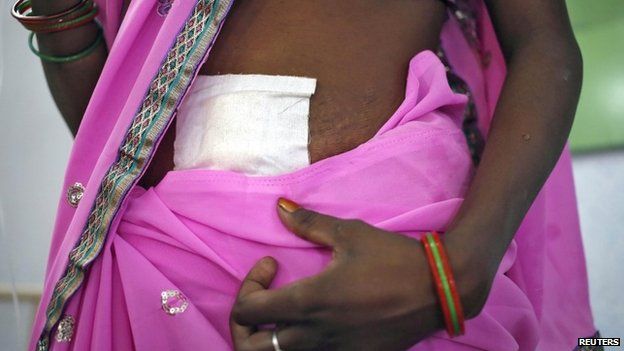India's dark history of sterilisation
-
Published

The death of 15 women at two state-run sterilisation camps in Chhattisgarh has put a spotlight on India's dark history of botched sterilisations.
The drive to sterilise began in the 1970s when, encouraged by loans amounting to tens of millions of dollars from the World Bank, the Swedish International Development Authority and the UN Population Fund, India embarked on an ambitious population control programme.
During the 1975 Emergency - when civil liberties were suspended - Sanjay Gandhi, son of the former Prime Minister Indira Gandhi, began what was described by many as a "gruesome campaign" to sterilise poor men. There were reports of police cordoning off villages and virtually dragging the men to surgery.
The campaign also made an appearance in Salman Rushdie's novel, Midnight's Children.
An astonishing 6.2 million Indian men were sterilised in just a year, which was "15 times the number of people sterilised by the Nazis", according to science journalist Mara Hvistendahl. Two thousand men died from botched operations.
"India has a dark history of state-sponsored population control, often with eugenic aims - targeting the poor and underprivileged," Ms Hvistendahl told me. "The women's tragic deaths [in Chhattisgarh] show that it still happens today."
Since family planning efforts began in the 1970s, India has focused its population control efforts on women, even though, as scientists say, sterilisations are easier to perform in men. "This may be because women are deemed less likely to protest," says Ms Hvistendahl.
India carried out nearly 4 million sterilisations during 2013-2014, according to official figures. Less than 100,000 of these surgeries were done on men. More than 700 deaths were reported due to botched surgeries between 2009 and 2012. There were 356 reported cases of complications arising out of the surgeries.
Though the government has adopted a raft of measures and standards for conducting safe sterilisations, an unseemly haste to meet high state-mandated quotas has often led to botched operations and deaths.
Women have died from forced sterilisations in China where population control was institutionalised since the 1980s. "But the conditions in Indian sterilisation camps sound worse," says Ms Hvistendahl. There have been reports of the appalling quality of tubectomies for many years now, and authorities still don't seem to realise that it is an important reproductive health concern. And the shoddy surgeries continue, risking the lives of poor women.